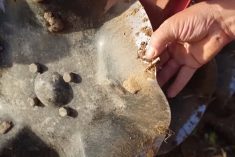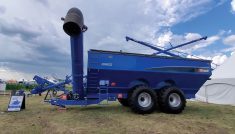At the Crop Production Show in Saskatoon in January, Brandt gave farmers their first look at the company’s new entry into the high-speed disc segment, the aptly named High-Speed Disc. It’s designed to work at 10 to 14 miles per hour and weighs in at around 1,000 pounds per foot, giving it adequate downforce to work even in tough soil conditions.
- VIDEO: Brandt high-speed disc
With a lot of other high-speed discs already on the market, the company had the advantage of looking at what features worked best on competitors’ machines before finalizing their own design.

“When our engineers were working on this, they looked at what’s out there now and put together what they thought were the best features out on the marketplace already, and they added some nice features that maybe weren’t on any of the other discs,” says Scott Lessmeister, Canadian regional sales manager at Brandt. “There are some advantages of being a late entry into the market.”
And the most common question he heard from farmers at the Saskatoon show was, “What’s different and new compared with what’s out there now?”
Lessmeister says one of the things that makes the High-Speed Disc stand out from the crowd is the broad range of options available, so growers can configure a disc to do exactly what they need it to do.
“We’ve got a very configurable machine,” he adds. “We have seven different working widths from 16 feet right up to 45 feet. We have two different sizes, a 20-inch and 22-inch disc. And we have three different disc styles, a smooth, concave disc, a U-notch and a fluted or saw-toothed disc.
“We also have three different rear finishing options. We have the rubber packer option. And then we also have the rolling basket or cage roller and a spring roller. You can configure the machine in a number of different ways — you can tailor it for what your priorities are or what you want to get out of that machine.”

One of the design features engineers came up with for the Brandt disc is a suspension system for the rear finishing rollers.
“Instead of a rigid link to the frame, there’s actually two rubber pucks that act as shock absorbers,” Lessmeister says. “If you hit rocks or other obstacles, it really absorbs that impact and doesn’t let it carry through to the rest of the frame.”
Another feature that proved valuable during field trials was the location of hydraulic lines.
“One thing we noticed in the prototyping was in the placement of our hydraulic lines,” he says. “It may seem insignificant, but we noticed when a farmer was done with a particular field and put the machine into transport, the machine left the field with very little dirt on the frame. Because of the placement of the hydraulic lines, it doesn’t catch the dirt. With clubroot and things like that, cross-contamination from one field to the next has become more of an issue. The cleaner the equipment can be when it leaves one field and goes into another, that’s a fairly significant benefit. And as you can imagine, at 14 miles per hour these things throw a lot of dirt.”
Although discs were in very high demand during the several consecutive wet growing seasons in the previous decade, recent drier Prairie conditions have slowed sales a bit. However, Lessmeister believes growers will still find a need for discs.
“Now that it’s dry, there are a lot of dried up slough bottoms that guys are trying to reclaim,” he says. “It can be used for trash management, soil bed preparation, filling in ruts or reclaiming wetlands, (as well as) slough bottoms, things like that. And it’s designed to do that with the least number of passes possible.”

The Brandt High-Speed Disc demands an average of 20 horsepower per foot of working width from a tractor, and the two largest disc models will need a 600-plus-horsepower machine in front of them.
“When you get up to the larger 41- and 45-foot sizes, you really have to be mindful of what horsepower you have available,” he says. “Ideally, you want 20 horsepower per foot to pull at the speed it does the best job. You can get by with less horsepower, but you probably won’t be able to pull it at the higher speeds or maybe go as deep as you might like.”
The new disc is now available for order, and Brandt expects to have them ready for dealer delivery in time for the 2022 season.
Read Also

Claas brings 1000 Series SP forage harvesters to Canada
In mid-August, Claas unveiled its new line of Jaguar forage harvesters at an event in Visalia, California, deep in the heart of that state’s dairy region.
“We’ve just moved out of our prototyping stage,” says Lessmeister. “We had five units in the field last spring and fall that we were prototyping. Now we’re into our commercial production, which will be starting later this winter. The plan is to have 50 of these delivered to our dealers and, hopefully, in the field this spring.”
















